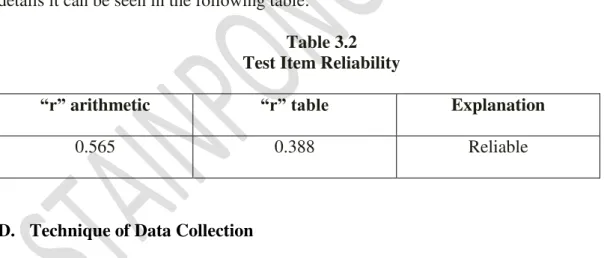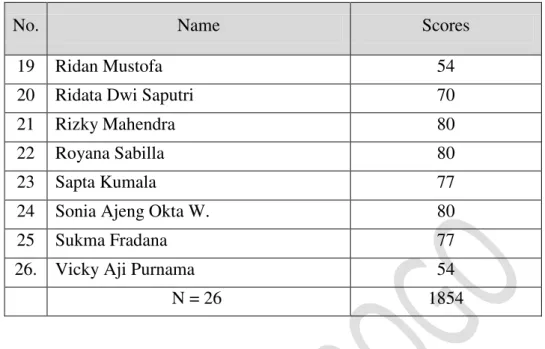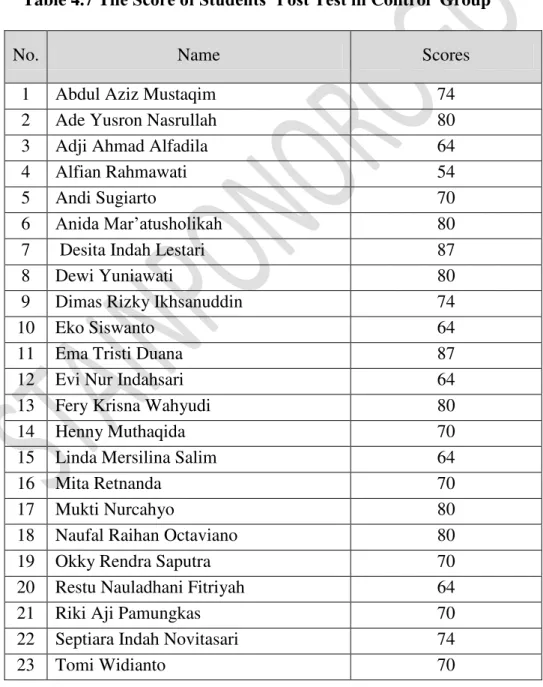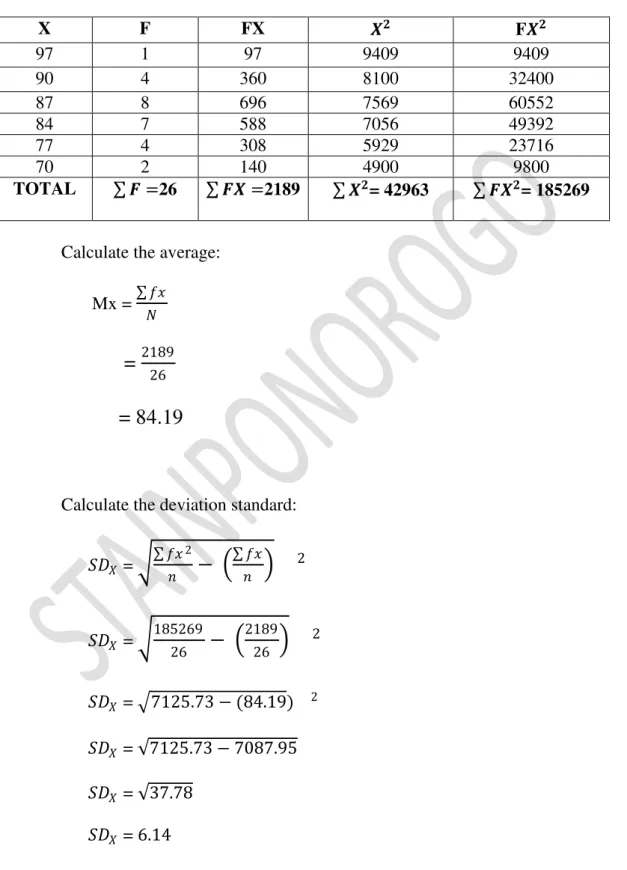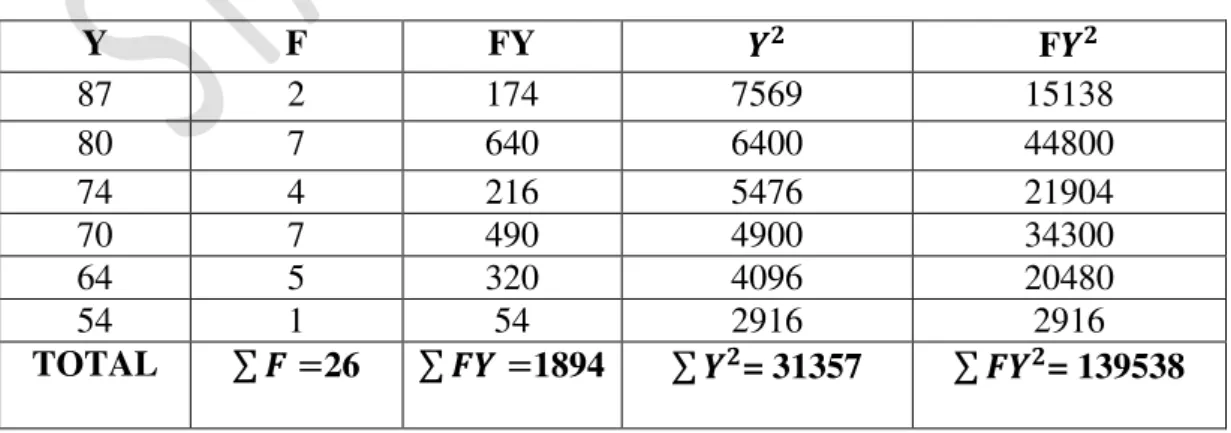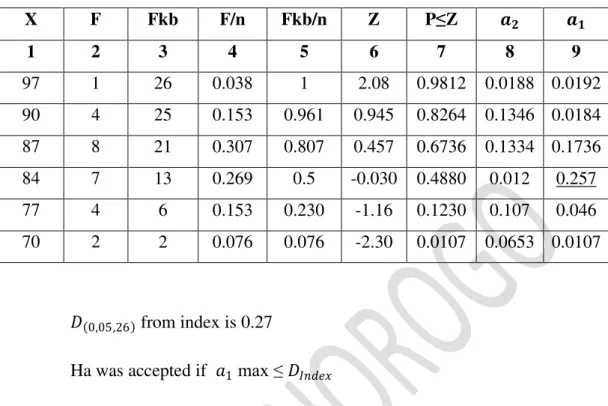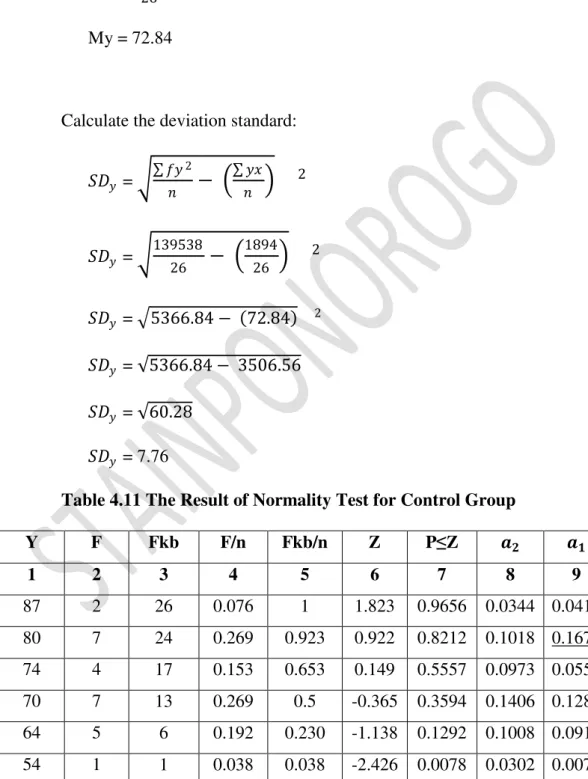The subject of the study is seventh grade students at SMPN 1 Sawoo in the academic year 2014/2015. The purpose of this study is the effectiveness of brainstorming techniques on students' reading comprehension.
Theoretical Background 5. Reading
Reading Technique
The while is activity during the reading phase or the actual reading of the text. If the phase is already/during reading, the students are expected to have extracted new information from the text.
Types of Brainstorming
Richards found that interaction between students was an important part of developing the cognitive skills involved in idea generation. From the above definition, the researcher concluded that brainstorming is the technique of activating the prior knowledge before reading or before students read a text which is used in the actual research to activate the student's prior knowledge and help the students make connections with their own life experiences. , which engages the students and gives them a stronger reading purpose.
The Advantages of Brainstorming
So that the teacher can list on the board all or some of the information students "brainstorm" from reading the title. This approach can bring better and more complete ideas than just producing ideas.30 It means that with a better idea it can solve the problem that occurs when students read a text. Brainstorming process in teaching reading comprehension Teacher applied brainstorming in class before reading is helping students to activate their prior knowledge or share other people's knowledge about text content and improve their comprehension of reading.
In a brainstorming session, the students get ideas from their brains that they already know about the topic of the text. As a reading exercise, the teacher announces the subject of the text to be read and writes it on the board.
Previous Research Finding
Rather, it is a practical technique that does not take up too much time and leaves much of the reading session time for the reading process itself.32 Thus, through activated brainstorming before reading it can help the readers to focus attention, speed up reading, to improve reading comprehension and activate prior knowledge and also to see how much effect this has on the readers' reading comprehension performance. Another research that is similar to this research was thesis of Susmiarti under the title "improving students' reading comprehension through round-robin brainstorming technique.34 This research was a classroom action research. The research finding related to the previous study was moreover of Muayyad Mohammed Saed.35 The study aims to determine the effectiveness of using brainstorming (BS) as a technique for teaching reading comprehension in advanced ESP courses.
Ahmed Mansrah, "The Importance of Brainstorming in Improving ESP Reading Comprehension," International Journal of Arts and Commerce, Vol. The technique used should be a communicative material to help students understand the text.
Theoretical Framework
On the other hand, students will enjoy getting as involved as possible in reading lessons. With the Brainstorming technique, an individual can produce twice as many ideas as if he works alone, as stated by Alex Osborn.38 In addition, by using the Brainstorming technique, students can improve their ability to understand the text, and the researcher believes that the students feel more interested, easy, and of course, they will be motivated to learning and understanding the subject. After that, the researcher observed this process to see if there is any significant difference in achievement between the students who were taught brainstorming and those who were not taught brainstorming in the seventh grade of SMPN 01 Sawoo in the academic year 2014/2015 .
37 Perviz Ajideh, "Schema-theory Based Considerations on Pre-Leading Activities in ESP Textbooks", The Asian EFL Journal. The researcher assumes that there are many pre-reading techniques, but using the brainstorming technique in the seventh grade of SMPN 01 Sawoo is effective to achieve better results in reading comprehension.
Hypothesis
RESEARCH METHOD
Research Design
Quasi-experimental research is research that directly tries to influence a certain variable, and if used correctly, it is the best type for testing hypotheses about a cause-and-effect relationship.41 This design should meet the goal of this research, ie. to know whether there is a significant difference in student achievement produced by the use of a particular treatment. In a non-equivalent (pre- and post-test) control group design, a popular quasi-experimental approach, experimental group A and control group B were selected without random assignment. They were taught by a classroom teacher, who used the usual teaching method, such as: directing students to read aloud; use of silent reading; teacher-led questioning; requests re-reading of elements of the text where she considered it necessary; ask students to highlight elements of the text; and completing written exercises related to the reading.
Here, both the experimental and control classes were tested before and after on their knowledge of the information contained in the measurements. Pre-treatment pre-test to ensure that students are in the same condition and to know the students' reading comprehension performance and post-treatment post-test to measure the effects of that treatment.
Population and Sample 1. Population
- Sample
For those classes, the researcher selected two seventh grade classes as the experiment class and the controlled class. To select the samples, the researcher took the data of the reading test that was given by the teacher. Then, from the results of the reading scores, the researcher measured the mean and standard deviation of the classes to know whether or not the classes had similar ability characteristics.
Then, two classes were selected among the three classes to be taken by lot as the experimental class and the control class. So, before the data were tested in the experimental and control classes, their validity should be checked.
Intrument of Data Collection
- Test of Validity
- Test of Reliability
Cluster random sampling or sampling area (group) is determined by sampling areas or groups that exist in the population such as a school, class, region, rather than an individual.48 The researcher chose this sampling technique because it was cluster random sampling easier to implement and manageable than other techniques. In this research, the researcher used a reading comprehension test already prepared by the teacher to determine the effectiveness of the brainstorming technique. Therefore, the researcher used an instrumental test with two tests, the first test is the validity test and the second test is the reliability test.
But the researcher still uses 30 questions to collect data with the revision test because the questions can measure the special purposes which are similar to the given material or content. Reliability defined as the level of internal consistency or stability of the measuring device over time.56 In this research, the researcher uses a method from Kuder-Richardson.
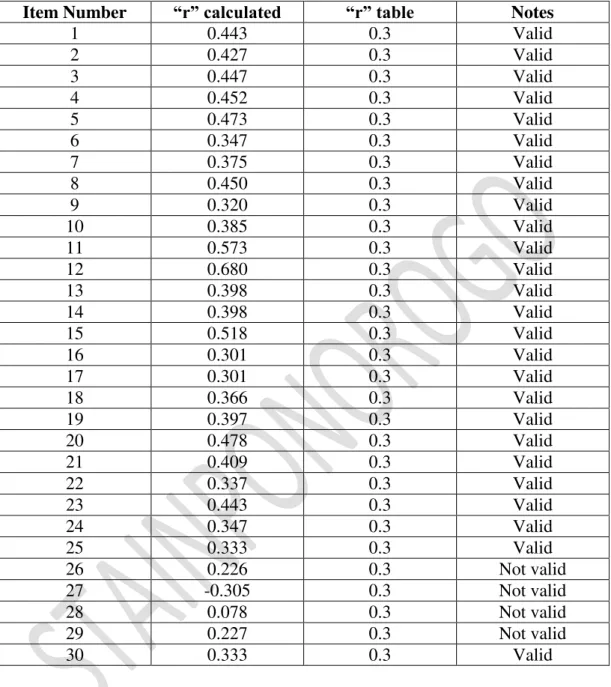
Technique of Data Collection
- Tests
- Interview
- Documentation
In simple terms, a test is a method to measure a person's abilities, knowledge or performance in a given domain.58 Therefore, the researcher can easily measure the students' abilities. Interviews are used as data collection techniques to conduct a preliminary study to find problems to be investigated and also to know things that the respondents are more in-depth and the number of respondents little/small.59 So, the researcher conducts in the classroom observation. Unstructured interview is a free interview in which the researcher does not use the interview guide that has been organized in a systematic and comprehensive data collection.
Thus, the researcher uses this method to collect data about the state of the research object. In addition, the researcher also obtains data on the history of the school, vision, mission, goals, facilities, infrastructure and organization structure of SMPN 1 Sawoo.
Technique of Data Analysis
The documents used in this research were obtained from the students' results of the given test, the lesson plan for the teacher and the picture of the teaching-learning process. The calculated value of Z with the formula X is the original data value and μ is the population mean can be estimated using the sample mean or median while � was the standard deviation of the sample values. M1 = Mean of variable X (post-test) M2 = Mean of variable Y (post-test) SD1‟ = Standard deviation x variable SD2‟ = Standard deviation y variable SEM1‟ = Standard error of variable x SEM2‟ = Standard error of variable y.
SEM1-M2 = Standard error between mean of variable x and variable y R12 = the correlation coefficient between variable x and variable y. Σf1‟ = the total number of scores of x variable Σf2‟ = the total number of scores of x variable Σf12 = the total number of square scores of x variable.
- Time of the Research
Teachers must act as counselors to students in developing creativity and their own potential, and as motivators who help students raise their goals and aspirations. This greatly affects the school's performance in efforts to improve the quality of education. The researcher conducted the research on students of the seventh grade, because there is a big problem in the seventh grade.
The students often forget some material that the teacher explained and also the students have a little vocabulary. This is as an interview on 20 December 2014 with an English teacher at the seventh grade in SMPN 01 Sawoo, Mrs.
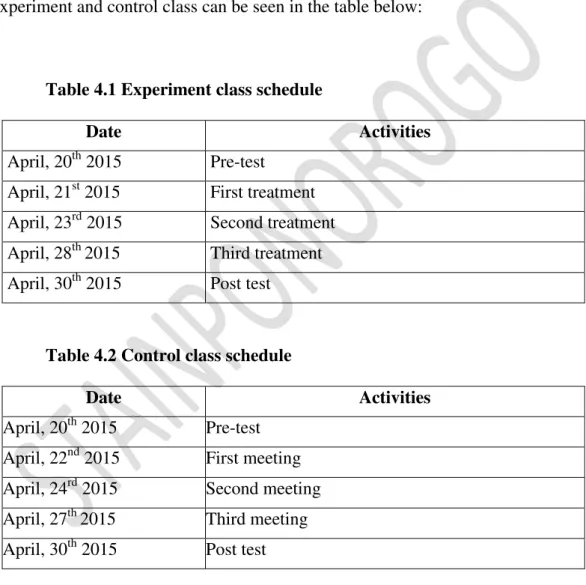
Data Description
- Procedure of Experiment
- Procedure of Control
- The Result of Students’ Pre Test in Experimental Group (7E)
- The Result of Students’ Pre Test in Control Group (7C)
- The Result of Students’ Post Test in Experimental Group (Variable X) The table below showed the score of the post test of the students taught
- The Result of Students’ Post Test in Control Group (Variable Y)
- The Result of Assumption Test for Parametric Statistic a. Normality
The table below showed the score of the pre-test of the students who were taught by brainstorming technique. The table below showed the score of the pre-test of the students who were not taught by brainstorming technique. So, it could be concluded, the post-test of the students who were taught by brainstorming technique was good.
The table below shows the post-test score of students who were not taught using the brainstorming technique. From the table above, it could be seen that the post-test of the students in the control group who were not taught using the brainstorming technique was variety.
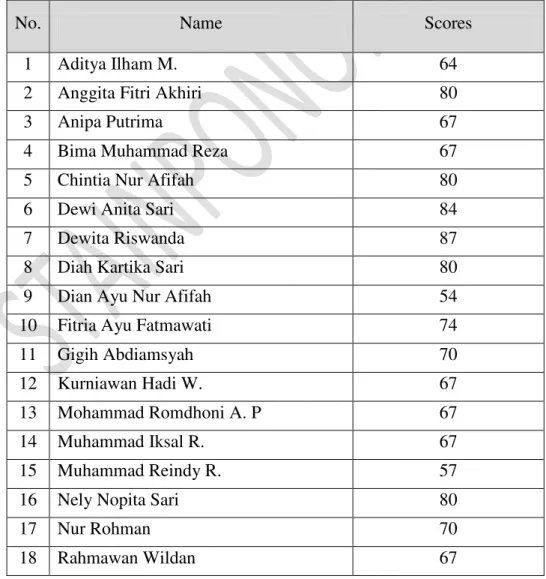
Data Analysis
- The Analysis of Student’s Post Test of Experimental Group
- The Analysis of Student’s Post Test of Control Group
- Testing Hypothesis ( )
So, from the above statistical data, it is known that the total range is 34, the class total is 6 and the interval is 6.
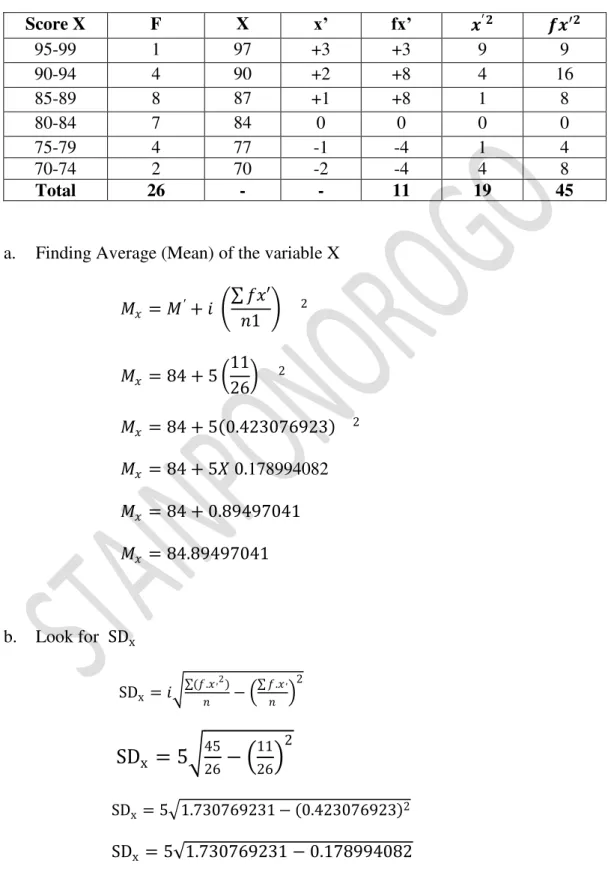
Discussion
Based on this statement, the researcher interprets that there was a significant difference between students taught using brainstorming technique and students who were not taught using brainstorming technique, this implies that students who learned using brainstorming technique achieve a better score in reading comprehension. So, the alternative hypothesis (�) was accepted, which states that students taught using the brainstorming technique will achieve a better result in reading. From the above data, the researcher could conclude that there was a significant difference in reading score between students taught using brainstorming technique and students who were not taught using brainstorming technique.
In other words, the brainstorming technique was effective in improving the reading comprehension achievement of students in the seventh grade of SMPN 1 Sawoo in the academic year 2014/2015. So, this technique made the student more interested and satisfied during the teaching and learning process.
CLOSING
Conclusion
Suggestion
